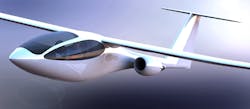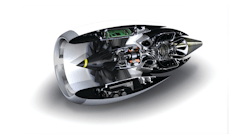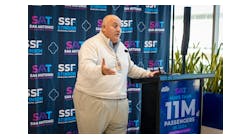Price Induction Announces Winners of the Personal Light Jet Student Design Contest
Marietta Georgia. May 29, 2013. One hundred and thirty two students from 23 colleges and universities around the globe registered in October 2012 for the Price Induction Personal Light Jet (PLJ) design competition. The contest asked aerospace engineering students to imagine and design the best Personal Light Jet based on a 4-seater twin engine jet equipped with the Price Induction DGEN 390 turbofan engines. In May 2013, only 11 teams submitted final projects in what resulted in a very challenging competition.
The highest scoring team was from Federal University of Minas Gerais in Brazil for their very innovative design the CEA-312. The Brazillian team presented an unusual configuration when compared to other proposals and models of personal jets. The proposed configuration was quite similar to a glider with the two engines mounted on the fuselage.
Christine Lloyd, North American Sales Representative for Price Induction and the organizer of the PLJ student design contest says, “The judges voted unanimously for the CEA-312 design liking the innovative design with an unusual configuration.” The design configuration was very focused on drag reduction, the ability to afford a very simple and light landing gear, and the design had superior aesthetics. The design also considered a very comfortable ergonomic package, not only in terms of seat position but also accessibility to the cockpit. “The great performance combined with this amazing design made the CEA-312 the perfect project to highlight the potential of the DGEN engine in the global general aviation marketplace” says Lloyd.
Students from the winning Brazilian team will enjoy an all-expense paid trip to the Paris Airshow in June, where Price Induction will be exhibiting the DGEN engine along with all their educational solutions including the WEST CS/BV Virtual Turbine Engine Test Bench. A prize-giving ceremony will take place on Thursday June 20th where people will be able to fly the CEA-312 on the virtual test bench.
Second place went to one of the two teams from Embry Riddle Aeronautical University in Daytona Beach Florida USA with the Aeolus, a blend of high efficiency and aesthetic beauty. It features a sleek sweptback wing design capable of carrying the aircraft to altitudes of 25,000 ft. The cabin was designed to maximize the available volume for pilot and passenger through clever placement of large components in other parts of the fuselage and by introducing a fly-by-wire system featuring small joysticks.
Third place was awarded to two projects scoring equally in the contest. The Qu-jet 128 D imagined by students from the Queen Mary University of London, and the Zephyr Eagle came from another team at Embry Riddle Aeronautical University’s Daytona Beach Campus. The QMUL designers bring rise to an efficient, sleek and luxury PLJ with a number of features other aircraft designs do not boast. The Qu-Jet design aimed to excel in PLJ design innovation while maintaining the core standards of high efficiency, low acquisition cost, low operation cost, and full utilization of the DGEN 390 engines.
The Zephyr Eagle design combined simplicity and elegance to culminate into a streamlined and efficient vehicle. The aircraft's straightforward design allowed for an exceptional amount of versatility and customizability. By being in a weight class all on its own and performing as the best step up from a propeller driven aircraft, the Zephyr Eagle proves that jets don't have to be big.
ABOUT THE DGEN PROGRAM
A new engine for a new class of airplanes.
Over the past ten years, Price Induction has been developing the DGENs, high by-pass ratio turbofans designed to motorize 4 to 5-seating Personal Light Jets (PLJ). The DGEN 380, providing up to 2.5kN of thrust, is the first product of a family of high bypass ratio engines that can provide up to 4kN of thrust and that are optimized for the general aviation flight domain (under 25’000ft, ISA+/- 30, under Mach number 0,4). The DGEN 380 has been designed with inherent robustness, easy integration and maintainability, low fuel consumption and noise level. These PLJ planes will thus be efficient, easily piloted by private individuals, with great safety of use and comfort, low pollution, low maintenance, with a sensible running cost.
About Price Induction
Price Induction Inc. is a subsidiary of Price Induction SA, French SMB based in the Aquitaine region, France, in Anglet (offices) and Tarnos (test bench). Today, the parent company employs around sixty people, more than forty of which are engineers. The company holds another two subsidiaries: one in Berlin, Germany and one in Sao José dos Campos SP, Brazil. Price Induction SA is an investment of the following funds which are managed by ACE Management: AEROFUND, ACE and Financière de Brienne. Price Induction SA is also actively supported by the Aquitaine Region, the FEDER and the OSEO and is a member of Aerospace Valley Global Aerospace Competitiveness cluster. http://www.price-induction.com/en/





